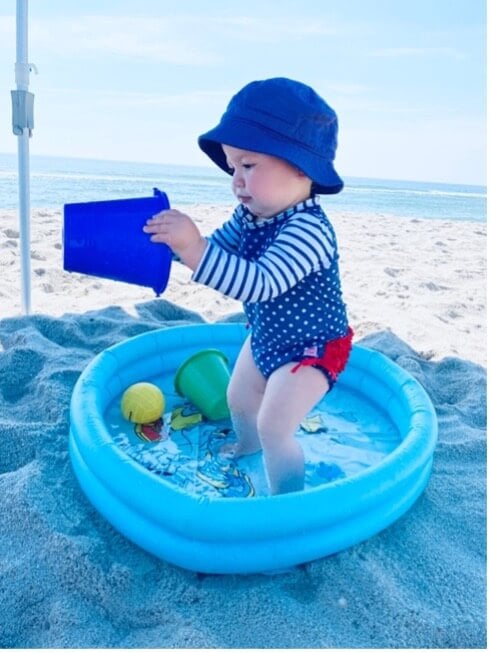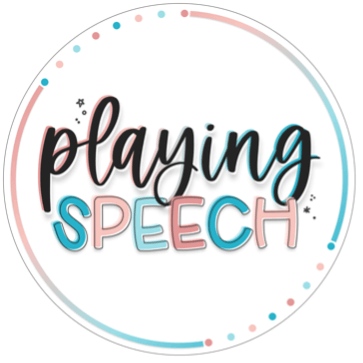
Guest Post: How to Target Early Language Speech Therapy the Beach!
Suzanne, SLP, is here with How to Target Early Language Speech Therapy the Beach!

Hi! My name is Suzanne and I’ve been an SLP for over a decade! I have worked with the lifespan, but currently focus my itinerant private practice on children with speech sound disorders and early language delay. I love working early language goals into daily routines. And when it comes to speech sound disorders, I believe in no/low prep activities that get you a ton of trials! You can hang with me on Instagram @playingspeech and on my website at playingspeech.com. When I’m not SLPing, I enjoy hanging out with my 3 toddlers, doing Crossfit, and reading all the things.
But anyway, enough about me, let’s get down to business and discuss how to target some common early language speech therapy goals at the beach!

There are so many opportunities to target a variety of goals when spending a day at the beach. You can easily work receptive and expressive language tasks into your sun-filled afternoon. And the best thing is, these goals can be targeted in a natural, fun, play-based way at the beach. Some possible target areas include spatial concepts, following directions, categories, and more. Let’s take a closer look at how we can incorporate these goals into a day at the beach!
Vocabulary
The beach is FULL of rich vocabulary words including nouns, verbs, and adjectives! Label the different items you brought to the beach as you unpack: beach chair, umbrella, blanket, towel, shovel, bucket, and more. Play a search-and-find game where the adult names something they see on the beach and the child has to find it. Or make the game a little more difficult by describing the item and having the child guess what it is. For example, say, “I see something you use to dig in the sand” and see if the child can guess “Shovel!”
Build a sand castle and talk about scooping, pouring, patting, digging, flipping, smashing! Go down to the ocean and splash, jump, fall, and spin. Say these action words as you are actually doing the action to really help the child link meaning to the word. Bonus points if you use a lot of repetition!
Talk about the sights, smells, and sounds you hear while relaxing in the sand using describing words: hot, rough, salty, smooth, wet, soft, loud, bumpy, breezy. When eating your beach snack, use words like yummy, sticky, sweet, juicy, and big! You can choose words that are simple or more complex for each task depending on the child’s current vocabulary.
Following Directions
There is a myriad of opportunities to work on following directions while at the beach. While building a sandcastle, have the child retrieve needed items (“Go get me the bucket and bring it here”). Work in temporal concepts when collecting seashells (“First pick up the shell, then put it in the bucket”). Target directions with spatial concepts while setting up your beach spot (“Put the beach chair under the umbrella” or “Put the toys on the blanket”). And don’t forget qualitative concepts directions as you’re digging in the sand (“Give me the big, blue shovel”).
Another great idea to work on following directions and get the little ones up and moving is to play a game of Simon Says while on the beach. And work in some beach vocabulary while you are at it! “Simon says find a shovel” or “Simon says sit in the sand” are perfect examples.

Spatial Concepts
Grab some shells and some sticks. Build a sandcastle and put shells on top, in front of, behind, and in the castle. You can also use a sand bucket to target prepositions. Put the shells in, under, behind, or on top of the bucket. I like to do this in a playful way so the child thinks it is a game. I say something like “Can you put the shell under the bucket?” with a silly, excited face. I use a visual/gestural cue if the child needs it (pointing to “under” or lifting the bucket up and glancing under it).
Play a game of hide the shell. Let the child hide the shell. It doesn’t matter if they hide it well or not. Make a big, exaggerate production of looking for it while stressing the prepositional words: “Is it UNDER the blanket? Nooooo! Is it NEXT TO the blanket?”
Categories
Things naturally fall into categories at the beach. Play a game where you put all buckets in one pile and the shovels in another. Hand the child one item at a time and ask “Does this go with the buckets or shovels?” Bonus points if you put the piles far away so the child can run back and forth between you and the piles. When you go collecting treasures on a beach walk, separate the shells from sticks and the seaweed. Talk about how seagulls are a type of bird and whales, fish, and dolphins are types of sea creatures. If the child has a larger vocabulary, play a game where the child has to name an item in a category! Say something like “Tell me some ocean animals you know.”

Increasing MLU
This goal is best targeted by expanding on a child’s utterances. For example, if the child points at a seagull in the air, and says “bird,” you can respond with “Yes! The bird is flying!” (I would also tell the child that that type of bird is called a seagull, but that’s more of a vocabulary goal). When digging in the sand, make up a silly song like “Dig, dig, dig. Dig in the sand.” This way, the child gets high repetitions of the single vocabulary word and then an expanded sentence in an easy to remember, sing-song way. Sing this song every time you dig!
Send little ones on a scavenger hunt by saying things like “Find me something that is NOT a shell” or “Go find an umbrella that is NOT blue.” You can also do this while collecting seashells and beach treasures. Ask the child to find you something that is not hard or a shell the is not broken!
So that’s it! I think we’ve got some really great ways to target basic early language goals while spending a day at the beach!
Here are the top 3 takeaways in case you like to skim:
1. You can easily work in receptive and expressive language goals at the beach!
2. Areas you can target include: vocabulary, spatial concepts, following directions, increasing MLU, cartegories, and negation.
3. All of these goals can be targeted in a fun, natural, play-based way at the beach!
If you want to check out more of my content you can find me on Instagram @playingspeech or come say hi over on my website!
Until next time,
Suzanne


